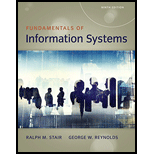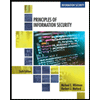
Fundamentals of Information Systems
9th Edition
ISBN: 9781337097536
Author: Ralph Stair, George Reynolds
Publisher: Cengage Learning
expand_more
expand_more
format_list_bulleted
Question
Chapter 1, Problem 11RQ
Program Plan Intro
The differences between the two types of innovations discussed in the chapter.
Expert Solution & Answer
Want to see the full answer?
Check out a sample textbook solution
Students have asked these similar questions
Why is Linux popular? What would make someone choose a Linux OS over others? What makes a server? How is a server different from a workstation? What considerations do you have to keep in mind when choosing between physical, hybrid, or virtual server and what are the reasons to choose a virtual installation over the other options?
Objective you will:
1. Implement a Binary Search Tree (BST) from scratch, including the Big Five (Rule of Five)
2. Implement the TreeSort algorithm using a in-order traversal to store sorted elements in a vector.
3. Compare the performance of TreeSort with C++'s std::sort on large datasets.
Part 1: Understanding TreeSort How TreeSort Works TreeSort is a comparison-based sorting algorithm that leverages a Binary Search Tree (BST):
1. Insert all elements into a BST (logically sorting them).
2. Traverse the BST in-order to extract elements in sorted order.
3. Store the sorted elements in a vector.
Time Complexity
Operation Average Case Worst Case (Unbalanced Tree)Insertion 0(1log n) 0 (n)Traversal (Pre-order) 0(n) 0 (n)Overall Complexity 0(n log n) 0(n^2) (degenerated tree)
Note: To improve performance, you could use a…
I need help fixing the minor issue where the text isn't in the proper place, and to ensure that the frequency cutoff is at the right place.
My code:
% Define frequency range for the plot
f = logspace(1, 5, 500); % Frequency range from 10 Hz to 100 kHz
w = 2 * pi * f; % Angular frequency
% Parameters for the filters - let's adjust these to get more reasonable cutoffs
R = 1e3; % Resistance in ohms (1 kΩ)
C = 1e-6; % Capacitance in farads (1 μF)
% For bandpass, we need appropriate L value for desired cutoffs
L = 0.1; % Inductance in henries - adjusted for better bandpass response
% Calculate cutoff frequencies first to verify they're in desired range
f_cutoff_RC = 1 / (2 * pi * R * C);
f_resonance = 1 / (2 * pi * sqrt(L * C));
Q_factor = (1/R) * sqrt(L/C);
f_lower_cutoff = f_resonance / (sqrt(1 + 1/(4*Q_factor^2)) + 1/(2*Q_factor));
f_upper_cutoff = f_resonance / (sqrt(1 + 1/(4*Q_factor^2)) - 1/(2*Q_factor));
% Transfer functions
% Low-pass filter (RC)
H_low = 1 ./ (1 + 1i * w *…
Chapter 1 Solutions
Fundamentals of Information Systems
Ch. 1 - Prob. 1LOCh. 1 - Prob. 2LOCh. 1 - Identify the three fundamental information system...Ch. 1 - Define the term the soft side of implementing...Ch. 1 - Identify and briefly describe five change models...Ch. 1 - Prob. 6LOCh. 1 - Prob. 1.1RQCh. 1 - Prob. 1.2RQCh. 1 - Prob. 1.1CTQCh. 1 - Prob. 1.2CTQ
Ch. 1 - Prob. 2.1RQCh. 1 - Prob. 2.2RQCh. 1 - Prob. 2.1CTQCh. 1 - What actions would you recommend to minimize...Ch. 1 - The value of information is directly linked to how...Ch. 1 - The value of information is directly linked to how...Ch. 1 - Prob. 3SATCh. 1 - Prob. 4SATCh. 1 - Prob. 5SATCh. 1 - Managers have an essential role to play in the...Ch. 1 - Managers have an essential role to play in the...Ch. 1 - Information systems must be implemented in such a...Ch. 1 - Information systems must be implemented in such a...Ch. 1 - Prob. 10SATCh. 1 - Prob. 11SATCh. 1 - Information systems must be implemented in such a...Ch. 1 - Prob. 13SATCh. 1 - Information systems must be implemented in such a...Ch. 1 - Prob. 15SATCh. 1 - Prob. 16SATCh. 1 - The information system worker functions at the...Ch. 1 - Prob. 18SATCh. 1 - Prob. 1RQCh. 1 - Prob. 2RQCh. 1 - Prob. 3RQCh. 1 - Prob. 4RQCh. 1 - Prob. 5RQCh. 1 - Prob. 6RQCh. 1 - Prob. 7RQCh. 1 - Prob. 8RQCh. 1 - Prob. 9RQCh. 1 - Prob. 10RQCh. 1 - Prob. 11RQCh. 1 - Prob. 12RQCh. 1 - Prob. 13RQCh. 1 - Prob. 14RQCh. 1 - Prob. 15RQCh. 1 - Prob. 16RQCh. 1 - Prob. 17RQCh. 1 - Prob. 18RQCh. 1 - Prob. 1DQCh. 1 - Prob. 2DQCh. 1 - Prob. 3DQCh. 1 - Prob. 4DQCh. 1 - Prob. 5DQCh. 1 - Prob. 6DQCh. 1 - Prob. 7DQCh. 1 - Your manager has asked for your input on ideas for...Ch. 1 - Prob. 9DQCh. 1 - Prob. 10DQCh. 1 - Prob. 11DQCh. 1 - Prob. 12DQCh. 1 - Prob. 1PSECh. 1 - Prob. 2PSECh. 1 - Prob. 3PSECh. 1 - Prob. 1WECh. 1 - Prob. 2WECh. 1 - Prob. 3WECh. 1 - Prob. 1CECh. 1 - Prob. 2CECh. 1 - Prob. 3CECh. 1 - Prob. 1.1CSCh. 1 - Prob. 1.2CSCh. 1 - Prob. 1.3CSCh. 1 - Prob. 2.1CSCh. 1 - Prob. 2.2CSCh. 1 - Prob. 2.3CS
Knowledge Booster
Similar questions
- My code is experincing minor issue where the text isn't in the proper place, and to ensure that the frequency cutoff is at the right place. My code: % Define frequency range for the plot f = logspace(1, 5, 500); % Frequency range from 10 Hz to 100 kHz w = 2 * pi * f; % Angular frequency % Parameters for the filters - let's adjust these to get more reasonable cutoffs R = 1e3; % Resistance in ohms (1 kΩ) C = 1e-6; % Capacitance in farads (1 μF) % For bandpass, we need appropriate L value for desired cutoffs L = 0.1; % Inductance in henries - adjusted for better bandpass response % Calculate cutoff frequencies first to verify they're in desired range f_cutoff_RC = 1 / (2 * pi * R * C); f_resonance = 1 / (2 * pi * sqrt(L * C)); Q_factor = (1/R) * sqrt(L/C); f_lower_cutoff = f_resonance / (sqrt(1 + 1/(4*Q_factor^2)) + 1/(2*Q_factor)); f_upper_cutoff = f_resonance / (sqrt(1 + 1/(4*Q_factor^2)) - 1/(2*Q_factor)); % Transfer functions % Low-pass filter (RC) H_low = 1 ./ (1 + 1i * w *…arrow_forwardI would like to know the main features about the following three concepts: 1. Default forwarded 2. WINS Server 3. IP Security (IPSec).arrow_forwardmap the following ER diagram into a relational database schema diagram. you should take into account all the constraints in the ER diagram. Underline the primary key of each relation, and show each foreign key as a directed arrow from the referencing attributes (s) to the referenced relation. NOTE: Need relational database schema diagramarrow_forward
- What is business intelligence? Share the Business intelligence (BI) tools you have used and explain what types of decisions you made.arrow_forwardI need help fixing the minor issue where the text isn't in the proper place, and to ensure that the frequency cutoff is at the right place. My code: % Define frequency range for the plot f = logspace(1, 5, 500); % Frequency range from 10 Hz to 100 kHz w = 2 * pi * f; % Angular frequency % Parameters for the filters - let's adjust these to get more reasonable cutoffs R = 1e3; % Resistance in ohms (1 kΩ) C = 1e-6; % Capacitance in farads (1 μF) % For bandpass, we need appropriate L value for desired cutoffs L = 0.1; % Inductance in henries - adjusted for better bandpass response % Calculate cutoff frequencies first to verify they're in desired range f_cutoff_RC = 1 / (2 * pi * R * C); f_resonance = 1 / (2 * pi * sqrt(L * C)); Q_factor = (1/R) * sqrt(L/C); f_lower_cutoff = f_resonance / (sqrt(1 + 1/(4*Q_factor^2)) + 1/(2*Q_factor)); f_upper_cutoff = f_resonance / (sqrt(1 + 1/(4*Q_factor^2)) - 1/(2*Q_factor)); % Transfer functions % Low-pass filter (RC) H_low = 1 ./ (1 + 1i * w *…arrow_forwardTask 3. i) Compare your results from Tasks 1 and 2. j) Repeat Tasks 1 and 2 for 500 and 5,000 elements. k) Summarize run-time results in the following table: Time/size n String StringBuilder 50 500 5,000arrow_forward
- Can you please solve this without AIarrow_forward1. Create a Vehicle.java file. Implement the public Vehicle and Car classes in Vehicle.java, including all the variables and methods in the UMLS. Vehicle - make: String model: String -year: int + Vehicle(String make, String, model, int, year) + getMake(): String + setMake(String make): void + getModel(): String + setModel(String model): void + getYear(): int + set Year(int year): void +toString(): String Car - numDoors: int + numberOfCar: int + Car(String make, String, model, int, year, int numDoors) + getNumDoors(): int + setNumDoors (int num Doors): void + toString(): String 2. Create a CarTest.java file. Implement a public CarTest class with a main method. In the main method, create one Car object and print the object using System.out.println(). Then, print the numberOfCar. Your printing result must follow the example output: make Toyota, model=Camry, year=2022 numDoors=4 1 Hint: You need to modify the toString methods in the Car class and Vehicle class!arrow_forwardCHATGPT GAVE ME WRONG ANSWER PLEASE HELParrow_forward
- HELP CHAT GPT GAVE ME WRONG ANSWER Consider the following implementation of a container that will be used in a concurrent environment. The container is supposed to be used like an indexed array, but provide thread-safe access to elements. struct concurrent_container { // Assume it’s called for any new instance soon before it’s ever used void concurrent_container() { init_mutex(&lock); } ~concurrent_container() { destroy_mutex(&lock); } // Returns element by its index. int get(int index) { lock.acquire(); if (index < 0 || index >= size) { return -1; } int result = data[index]; lock.release(); return result; } // Sets element by its index. void set(int index, int value) { lock.acquire(); if (index < 0 || index >= size) { resize(size); } data[index] = value; lock.release(); } // Extend maximum capacity of the…arrow_forwardWrite a C program using embedded assembler in which you use your own function to multiply by two without using the product. Tip: Just remember that multiplying by two in binary means shifting the number one place to the left. You can use the sample program from the previous exercise as a basis, which increments a variable. Just replace the INC instruction with SHL.arrow_forwardusing r languagearrow_forward
arrow_back_ios
SEE MORE QUESTIONS
arrow_forward_ios
Recommended textbooks for you
 Principles of Information Systems (MindTap Course...Computer ScienceISBN:9781305971776Author:Ralph Stair, George ReynoldsPublisher:Cengage Learning
Principles of Information Systems (MindTap Course...Computer ScienceISBN:9781305971776Author:Ralph Stair, George ReynoldsPublisher:Cengage Learning Fundamentals of Information SystemsComputer ScienceISBN:9781337097536Author:Ralph Stair, George ReynoldsPublisher:Cengage Learning
Fundamentals of Information SystemsComputer ScienceISBN:9781337097536Author:Ralph Stair, George ReynoldsPublisher:Cengage Learning Principles of Information Security (MindTap Cours...Computer ScienceISBN:9781337102063Author:Michael E. Whitman, Herbert J. MattordPublisher:Cengage Learning
Principles of Information Security (MindTap Cours...Computer ScienceISBN:9781337102063Author:Michael E. Whitman, Herbert J. MattordPublisher:Cengage Learning Principles of Information Systems (MindTap Course...Computer ScienceISBN:9781285867168Author:Ralph Stair, George ReynoldsPublisher:Cengage Learning
Principles of Information Systems (MindTap Course...Computer ScienceISBN:9781285867168Author:Ralph Stair, George ReynoldsPublisher:Cengage Learning Information Technology Project ManagementComputer ScienceISBN:9781337101356Author:Kathy SchwalbePublisher:Cengage Learning
Information Technology Project ManagementComputer ScienceISBN:9781337101356Author:Kathy SchwalbePublisher:Cengage Learning Fundamentals of Information SystemsComputer ScienceISBN:9781305082168Author:Ralph Stair, George ReynoldsPublisher:Cengage Learning
Fundamentals of Information SystemsComputer ScienceISBN:9781305082168Author:Ralph Stair, George ReynoldsPublisher:Cengage Learning

Principles of Information Systems (MindTap Course...
Computer Science
ISBN:9781305971776
Author:Ralph Stair, George Reynolds
Publisher:Cengage Learning

Fundamentals of Information Systems
Computer Science
ISBN:9781337097536
Author:Ralph Stair, George Reynolds
Publisher:Cengage Learning

Principles of Information Security (MindTap Cours...
Computer Science
ISBN:9781337102063
Author:Michael E. Whitman, Herbert J. Mattord
Publisher:Cengage Learning

Principles of Information Systems (MindTap Course...
Computer Science
ISBN:9781285867168
Author:Ralph Stair, George Reynolds
Publisher:Cengage Learning

Information Technology Project Management
Computer Science
ISBN:9781337101356
Author:Kathy Schwalbe
Publisher:Cengage Learning

Fundamentals of Information Systems
Computer Science
ISBN:9781305082168
Author:Ralph Stair, George Reynolds
Publisher:Cengage Learning